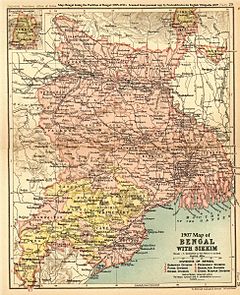| Odisha famine of 1866 Na'Anka Durbhikshya ନ'ଅଙ୍କ ଦୁର୍ଭିକ୍ଷ | |
|---|---|
 A 1907 map of Odisha, now Odisha, shown as the southwestern region of Greater Bengal. Coastal Balasore district was one of the worst-hit areas in the Odisha famine of 1866. | |
| Country | India |
| Location | Odisha |
| Coordinates | 20°23′54″N 84°24′09″E / 20.398464°N 84.402366°E |
| Period | 1866-1868 |
| Total deaths | 4-5 million |
| Causes | Drought |
| Relief | INR 9,500,000 |
| Net food imports | 40,000 tons of Food grains |
| Effect on demographics | Approximately 33% of the population died |
| Consequences | The famine also served to awaken Indians about the effects of British Raj. |
| Preceded by | Guntur famine of 1832 |
| Succeeded by | The Great Indian famine of 1876 |
The Orissa famine of 1866 affected the east coast of India from Madras northwards, an area covering 180,000 miles and containing a population of 47,500,000;[1] the impact of the famine, however, was greatest in the region of Orissa, now Odisha, which at that time was quite isolated from the rest of India.[2] In Odisha, the total number who died as a result of the famine was at least a million, roughly one third of the population.[3][4]
- ^ "The Orissa famine of 1866", by Ganeswar Nayak (PDF)
- ^ Imperial Gazetteer of India vol. III 1907, p. 486
- ^ Mohanty, Bidyut (2022). A haunting tragedy : gender, caste and class in the 1866 famine of Orissa. Abingdon, Oxon. ISBN 978-1-000-50673-0. OCLC 1266644011.
{{cite book}}: CS1 maint: location missing publisher (link) - ^ Patel, Dinyar (10 June 2016). "Viewpoint: How British let one million Indians die in famine". BBC News. Retrieved 10 June 2016.